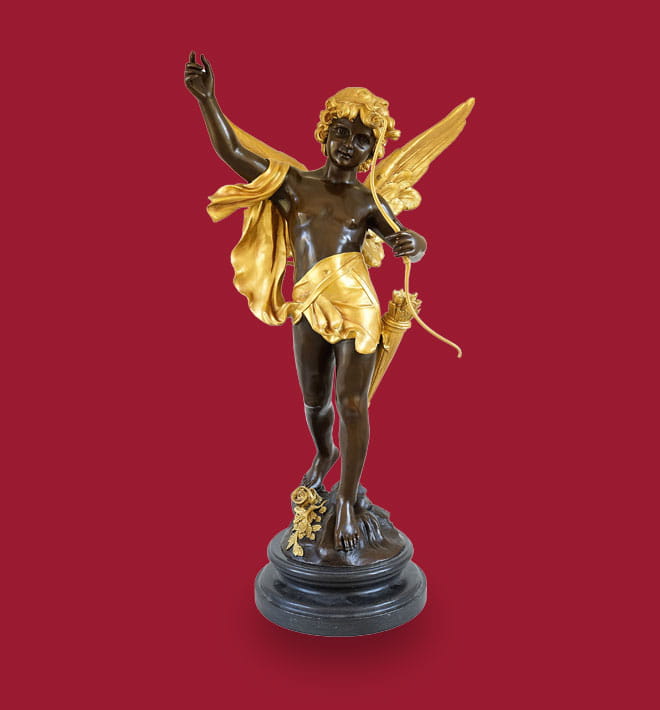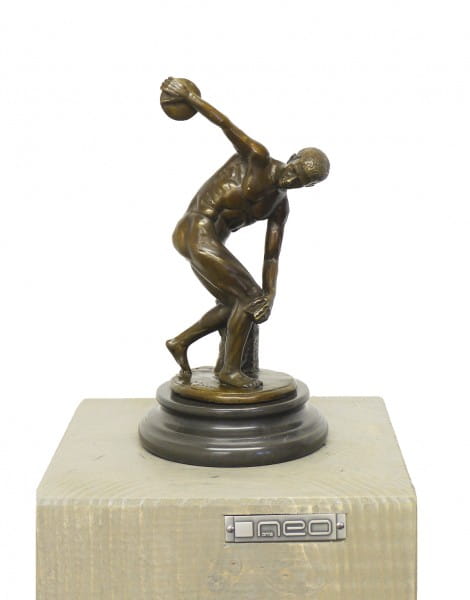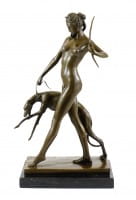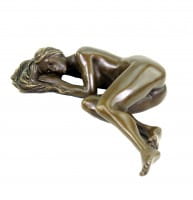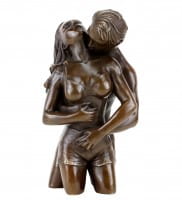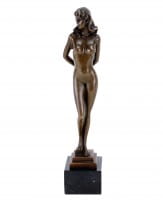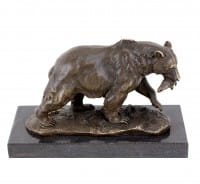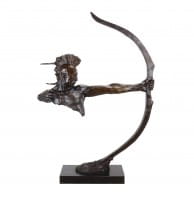Prices incl. VAT, free shipping worldwide
Ready to ship today,
Delivery time appr. 3-6 workdays










Product description
"Discobolus Bronze Statue - signed Myron"
| Weight | 2,1 kg |
Discobolus Bronze Statue – A Timeless Mastery - Signed Myron
Myron, born around 480 BCE in the small Boeotian town of Eleutherae (situated on the border of Attica and Boeotia), stands among the most celebrated sculptors of ancient Greece. Little is known of his early life beyond the fact that he flocked to Athens in his youth, drawn by the flourishing arts that took root in the aftermath of the Persian Wars. By the mid-5th century BCE, Myron had established himself as a master of anatomy and movement, forever altering the trajectory of Hellenic sculpture. He is believed to have died around 440 BCE, likely in Athens, after leaving behind a body of work renowned for its dynamism and harmonious proportions.
From Eleutherae to Athens
Eleutherae’s dusty lanes and rural rhythms offered Myron his first encounters with the sinuous forms of livestock and the sinewy tension of chained horses. These early impressions, combined with the intellectual ferment of Athens—home to Pericles, the rebuilding of the Acropolis, and theaters filled with the likes of Sophocles—nurtured in Myron a profound curiosity about how the body moves through space. It is said that Myron apprenticed under the sculptor Ageladas, absorbing not only the technical precision of the craft but also the philosophical underpinnings of ideal beauty. When he finally secured commissions in Athens, he crushed prevailing notions of static grandeur by infusing his figures with a breath of life, as though each marble block or molten bronze were poised at the height of an unseen action.
Forging the Iconic Discobolus
Around 450 BCE, in the very heart of Classical Athens, Myron conceived what would become his signature achievement: the discobolus statue. Crafted originally in bronze and displayed at the Panathenaic Games, this discobolus bronze immortalized the discus thrower at the instant of greatest tension—muscles coiled, eyes fixed on an invisible target, body arched in a perfect spiral of energy. Although no original bronze survives, later Roman marble copies (such as the famous Museo Nazionale Romano version) testify to the sheer ingenuity of Myron’s design. The rediscovery of these copies in Italy during the Renaissance inspired a revival of classical ideals, cementing the discobolus bronze statue as an enduring icon of athleticism and artistic balance.
Harmony in Motion
What sets the discobolus statue apart is its breathtaking synthesis of anatomy and geometry. Myron avoided accentuating individual muscles or anatomical minutiae; instead, he pursued an overarching unity—every limb, every sinew, every plane of the torso aligning to create a spiraling tension that readied the athlete for release. The shoulders roll back, the hips turn, and the legs brace against the earth with equal measure. In this singular gesture, Myron captured both the strain of exertion and the serenity of concentration. As the bronze once shimmered under Athenian sunlight, so too do modern reproductions reveal subtle gradations of light and shadow, accentuating the elegant curve of the spine and the taut sweep of the arm holding the discus.
Technical Brilliance in Bronze
For ancient Greek sculptors like Myron, bronze offered an unparalleled medium for capturing movement. Unlike marble, which required laborious extraction of form from stone, bronze—cast through the lost-wax method—allowed for more daring compositions. The original Discobolus would have been cast in multiple sections: the torso, each limb, and the head molded separately before being meticulously joined. The seams, smoothed by masterful chiseling and polishing, vanished beneath the warm glow of patinated metal. When the statue stood in the Athenian gymnasium or in a shrine to Athena, it must have gleamed with an almost life-like quality—an impression further heightened by the play of daylight rounding its surfaces. Even today, collectors and institutions prize discobolus bronze reproductions that seek to recreate the vibrancy of Myron’s process, replicating the subtle nuances of musculature and the poised tension poised to spring.
An Enduring Symbol
Today, the discobolus bronze statue remains a potent symbol in educational institutions, sports arenas, and private collections alike. As a celebration of the contest between body and force, it reminds us that true artistry lies in balance—between effort and grace, between strength and poise. Contemporary foundries strive to evoke Myron’s original brilliance by applying multi‐layered patinas: a lustrous brown base coat deepens into subtle shades of ochre and ebony in the recesses, while delicate burnishing on raised surfaces glints like living flesh. Enthusiasts of classical art and athletics value these discobolus bronze reproductions as conduits to the ancient world—tangible links to an age when the limits of human achievement were tested in the stadium of Olympia, and when sculptors like Myron translated that athletic fervor into forms that still speak to us across two and a half millennia.
Rediscovering Myron’s Genius
When one stands before a faithful rendition of the Discobolus, one cannot help but feel the resonance of that ancient moment—when the athlete’s breath stalled in a silent exhale, and the discus hovered poised to fly. This is not mere static art: it is a frozen crescendo, a snapshot of motion that elicits a visceral thrill even today. Myron’s daring revolution—transforming rigid stone and molten metal into vehicles of living energy—forever changed the story of sculpture. The discobolus statue invites us to remember that at its best, art does not simply depict life; it aspires to become life’s very echo, pulsating with the same rhythm of effort, anticipation, and graceful resolve.
Height: 25 cm
Width: 13 cm
Depth: 13 cm
Weight: 2,1 kg
100% Bronze
Our advantages
free shipping
Worldwide free shipping
14 days money back
You can cancel your order
within 14 days
secure payment services
Paypal, Master Card, Visa, American Express and more

